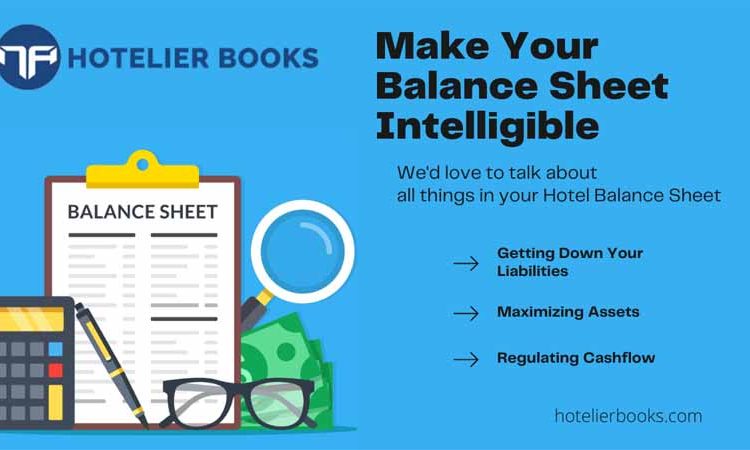If you own a hotel, you probably have a P&L statement or a balance sheet. It’s important to know what your business is making and how much it costs. It’s a good idea to review your order of glassware, china, and linen to make sure you don’t have an excess. The balances on your P&L statement are called debit balances. When they increase, they’re expenses.
Getting Down your Liabilities:
Liabilities represent the debts that your hotel has, including mortgages, loans, and credit card debt. These are a sign of how stable your business is. In contrast, your assets are your property, equipment, and financial assets, and represent the amount of money you have invested in the hotel. In addition, you can attribute any remaining assets to your equity. You can’t control your balance sheet, but you can take steps to monitor it for any potential issues.
When preparing your hotel’s balance sheet, you must be sure to include every expense, and all income. A balanced hotel balance sheet will show your overall financial health. This is especially important for new owners or those with a small budget. The most important part of the hotel balance sheet is the income statement. The cash generated from the revenue of your guests is your revenue. The other half of your income statement is the expenses. When you’re comparing these two, you can see if your hotel has expenses that are too high or too low.
A balance sheet is an essential tool for any hotel owner. It is a critical document that shows the state of your business. By knowing your assets and liabilities, you can make informed decisions and ensure the smooth operation of your hotel. A hotel balance sheet is a vital tool for the management of your hotel. You should understand it thoroughly before making any decisions. But remember, this is not an easy task. So, here are some important tips to help you better understand your hotel’s balance sheet and its contents.
Maximizing Asset:
A hotel balance sheet is a financial statement for a hotel. This document provides investors with information about the hotel’s asset, liabilities and equity. Hotel balance sheet usually include current assets – cash, long-term investments, inventory and receivables, property plant & equipment; current liabilities – accounts payable and accrued liabilities; non-current liabilities – long-term debt.
As hotels become more computerized, many managers of smaller properties use software that can generate their own hotel balance sheets.
Hotel balance sheets are also commonly used to track trends over time and as such, may be used in strategic planning processes.
A hotel balance sheet will often include the following components: A hotel operating statement which can be provided by a hotel accounting software is another tool used to manage hotels. The operating statement shows daily, weekly, monthly or yearly operating results. The goal is to develop an income statement that has a high degree of accuracy and useful in measuring and analyzing historical trends as well as in predicting future profitability.
In its simplest form, the income statement for a hotel includes two sections: revenues and expenses. The main difference between a profit/loss statement for a business organization and a hotel’s income statement is that revenues do not include sales of goods/services but instead focus on sales generated by the hotel itself i.e. gross hotel revenues. The primary purpose of a hotel operating statement is to provide a snapshot of the daily, weekly, monthly or yearly operating results for a particular period of time. A hotel operating statement can also be used to show trends over time and as such, may be used in strategic planning processes.
Making most form your Financial Reports:
A wide range of financial measures are commonly displayed on an income statement and as such, difficult to compare directly with profitability measures in other businesses. These financial measures might include: Hotel financial statements are primarily used internally by management to report on the performance and profitability of the company’s business operations.
The hotel balance sheet is an important tool for any business. It shows the value of assets and liabilities and gives you an overall picture of the hotel’s financial situation. In other words, a hotel balance sheet shows the value of its property and the cash it has on hand. As a result, the asset column shows the financial health of a hotel. Likewise, the liabilities section of the balance sheet reflects the amount of money a manager must pay in order to maintain a steady flow of revenue and profits.
The hotel balance sheet shows the values of its assets and liabilities. In addition, the hotel balance sheet shows the amount of cash and equity that it has. It is important to note that the assets and liabilities sections are crucial for the financial health of a hotel. As such, they are a vital tool for the management of a hotel. The information on a hotel balance sheet should be easily accessible and readable. It will provide a clear picture of the financial position of the business and allow the owner to make informed decisions.
The hotel balance sheet is essential to successful financial management. It details the assets and liabilities of a hotel. The liabilities section is the amount of debt a hotel owes to its creditors. On the other hand, the assets are the assets and capital of the hotel. The equity is the amount of cash that the hotel owns. In this way, it can show the financial health of the business. The equity of a hotel is its ownership.
A hotel’s balance sheet is a snapshot of the business’s financial situation. It contains the assets and liabilities of the hotel. The hotel’s assets can be divided into three categories: cash, accounts receivables, F&B inventory, and property. In general, the asset category is the most important. It is important for successful hotel management because it helps determine if there are any weaknesses in the business.






